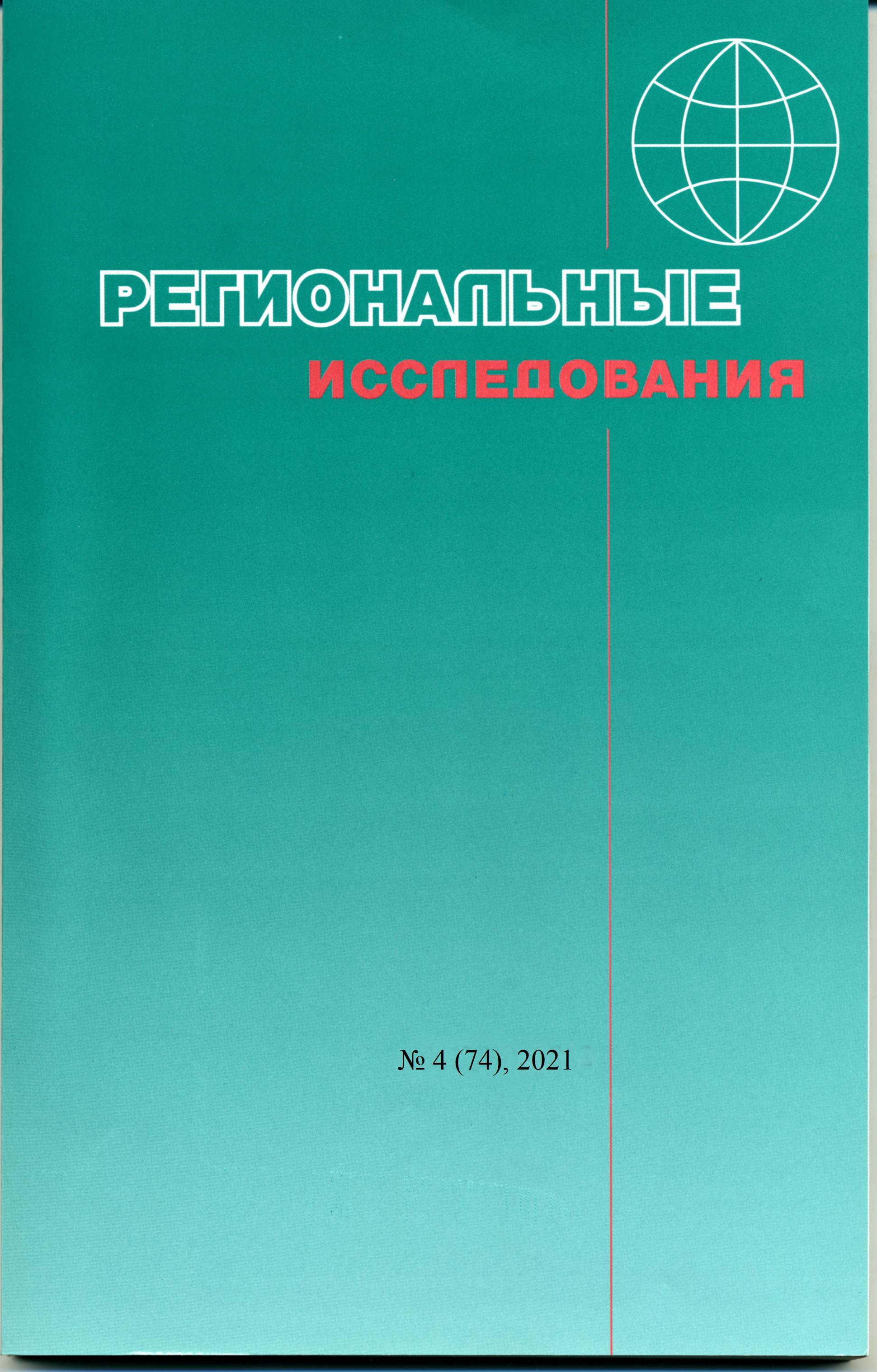Cherkashin A.K., Myadzelets A.V. Mathematical and statistical modeling of hierarсhy and heterarchy of economic-geographical systems
DOI:
https://doi.org/10.5922/1994-5280-2021-4-1Keywords:
hierarchical structure, heterarchy, territorial system, region, investment process, economic- geographical environment, mathematical modelingAbstract
The paper considers the structure of territorial economic-geographical system of Russian regions in the vertical (hierarchy) and horizontal (heterarchy) aspects using methods of mathematical modeling of a multilevel indicative function. It connects indicators of socio-economic development of regions and takes into account characteristics of the economic-geographical environment and regional spatial hierarchy. For the model calculations, we use data of dependence of the annual regional domestic in- vestment on the volume of industrial and agricultural production from 1999 to 2018. The calculated values of investment acceleration indicators vary in time and between regions. They reflect the variability of the economic-geographical environment at the different hierarchical levels. A logical chain of regression equations statistically describes the vertical hierarchy of the Russian economic system. Linear regional trends form groups, or congruencies, with similar norms of the socio-economic environment at the federal okrug level. The congruencies shape the all-Russian directive surface, or directress, and demonstrate diversity of the levels and directions of region development. Described in terms of the relationship between domestic investment and production volumes, the structure reflects the hierarchy of the Russian economic system at the regional, okrug and state levels and forms spatial heterarchical network of similarity of economic growth potentials.
References
Воронин А.А. Мишин С.П. Оптимальные иерархические структуры. М.: ИПУ РАН, 2003. 214 с.
Гранберг А.Г., Суслов В.И., Суспицын С.А. Многорегиональные системы: экономико-математическое исследование. Новосибирск: Сибирское научн. изд-во, 2007. 371 с.
Гурман В.И. Модели управления природными ресурсами. М.: Наука, 1981. 264 с.
Дилтс Р. Моделирование с помощью НЛП. СПб.: Изд-во «Питер», 1998. 300 с.
Камке Э. Справочник по дифференциальным уравнениям в частных производных первого порядка. М.: Наука, 1966. 256 с.
Месарович М., Мако Д., Такахара Я. Теория иерархических многоуровневых систем. М: Мир, 1973. 332 с.
Мосунов В.П., Никульников Ю.С., Сысоев А.А. Территориальные структуры районов нового освоения. Новосибирск: Наука, 1990. 153 c.
Новиков Д.А. Механизмы функционирования многоуровневых организационных систем. М.: Фонд «Проблемы управления», 1999. 161 с.
Попович А.Ю., Цыгичко В.Н. Проблема синтеза иерархических структур управления // Труды ИСА РАН. 2009. Т. 41. С. 233–246.
Саати Т. Принятие решений. Метод анализа иерархий. М.: Радио и связь, 1993. 278 с.
Саати Т. Принятие решений при зависимостях и обратных связях: Аналитические сети. М.: Изд-во ЛКИ, 2008. 360 с.
Угольницкий Г.А. Линейная теория иерархических систем. М.: Препринт Ин-та системного анализа РАН, 1996. 56 с.
Угольницкий Г.А. Иерархическое управление устойчивым развитием. М.: Изд-во физ.-мат. лит-ры, 2010. 336 с.
Угольницкий Г.А., Усов А.Б. Математическая формализация методов иерархического управления эколого-экономическими системами // Проблемы управления. 2007. № 4. С. 64–69.
Фролов Д.П. Многоуровневая иерархия экономического пространства: формирование эволюционной таксономии // Пространственная экономика. 2013. № 4. C. 122–150.
Хакимов Э.М. Моделирование иерархических систем. Теоретические и методологические аспекты. Казань: Казан.гос. ун-т, 1986. 160 с.
Хакимов Э.М. Диалектика иерархии и неирархии в философии и научном знании. Казань: Фэн АН РТ, 2007. 288 с.
Черкашин А.К. Система математических моделей леса // Планирование и прогнозирование природно-экономических систем. Новосибирск: Наука, 1984. С. 46–57.
Черкашин А.К. Модели и методы анализа территориальной организации общества // Региональные исследования. 2016. № 1 (51). С. 23–36.
Черкашин А.К. Метатеоретическое системное моделирование природных и социальных процессов и явлений в неоднородной среде // Информационные и математические технологии в науке и управлении. 2019. № 1 (13). С. 61–84.
Черкашин А.К. Теоретическая и метатеоретическая география // Географический вестник. 2020.№ 1(52). С. 7–21.
Черкашин А.К. Иерархическая классификация географических систем // Известия Иркутского государственного университета. Серия Науки о Земле. 2021. Т. 35. С. 124–152.
Черкашин А.К., Мядзелец А.В. Восстановление нелинейной зависимости качества жизни населения от социально-экономического потенциала регионов Сибири // География и природные ресурсы. 2014. № 4. С. 122–130.
Черкашин А.К., Мядзелец А.В. Характеризация развития региональной экономки с учетом макроэкономических факторов и условий // Экономика и математические методы. 2017. № 4 (53). С. 13–25.
Шупер В.А. Самоорганизация городского расселения. М.: Росс.открытый ун-т, 1995. 168 с.
Яшева Г.А. Кластерная концепция повышения конкурентоспособности предприятий в контексте сетевого сотрудничества и государственно-частного партнерства. Витебск: УО «ВГТУ», 2010. 373 с.
Dopfer K., Potts J. The General Theory of Economic Evolution. London, New York: Routledge, 2007. 152 p.
Fioretti G. Two measures of organizational flexibility // Journal of Evolutionary Economics. 2012. Vol. 22. № 5. P. 957–979.
Guerriero V. Power law distribution: method of multi-scale inferential statistics // Journal of Modern Mathematics Frontier (JMMF). 2012. № 1. P. 21–28.
Hewings G.J.D., Sonis M., Boyce D. Trade, Networks and Hierarchies: Modeling Regional and Inter-regional Economies. Berlin, Heidelberg: Springer-Verlag, 2002. 468 p.
Hierarchy in Natural and Social Sciences / ed. Pumain D. Netherlands: Springer, 2006. 246 p.
Hoskova-Mayerova S., Maturo F., Kacprzyk J. Mathematical-statistical models and qualitative theories for economic and social sciences. Cham, Switzerland: Springer International Publ., 2017. 577 p.
Miles R.E., Snow C.C. Fit, Failure, and the Hall of Fame. New York: The Free Press, 1994. 215 p.
Schroeder H. Application possibilities of the micro-meso-macro framework in economic geography // Papers in Evolutionary Economic Geography. 2011. № 11.15. P. 1–28.
Verspagen B. The spatial hierarchy of technological change and economic development in Europe // Annals of Regional Science. 2010. Vol. 45. P. 109–132.

